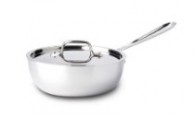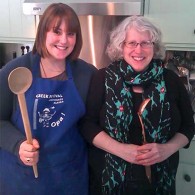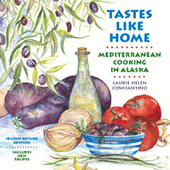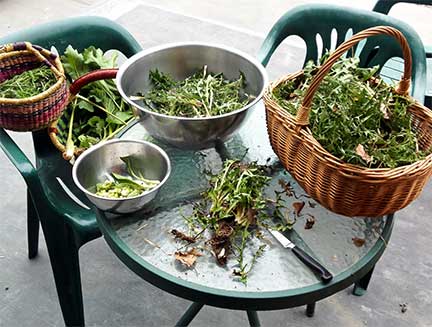
Horta to Clean: Plantain, Yarrow, Cow Parsnip, Dandelions. Photograph by Laurie Constantino
Eager to ensure enthusiasm doesn’t get the better of my taste buds, I’ve been carrying samples of foraged food with me wherever I go and offering tastes to anyone and everyone. Wild chips, roasts, curries, and ice creams are my calling card as I investigate whether my recipes have more than idiosyncratic appeal.
Foraging energizes and grounds me. I try my best to help others find this joy. After tasting wonderful wild flavors, many want to start foraging immediately: the more, the merrier! A side benefit of eating wild foods is an increased understanding of the need to protect ecosystems that sustain foraging.
One of my friends who’d tried and loved my recent recipes (roasted cow parsnips, Greek cow parsnip salad, and cow parsnip chips), was inspired to find and prepare her own. She also harvested devil’s club leaf shoots and fiddlehead ferns. She enjoyed all three plants, but shortly thereafter suffered acute intestinal distress, as did her guests.
Fiddleheads were the culprit. Although ostrich fern fiddleheads are edible and desirable, other look-alikes may be toxic or carcinogenic. Fiddleheads must be carefully cleaned and thoroughly cooked; if not, as my friend learned the hard way, they can make people sick.
I gave up on fiddleheads long ago. I don’t have the patience to sort good from bad; the differences are too subtle for me. In any case, I’d rather pick devil’s club, which comes to life the same time as fiddleheads and has way more flavor. I’m not advising against picking fiddleheads, just saying if you do, be very certain they’re actually ostrich ferns and cooked all the way through.
Eight Important Rules for Safe and Ethical Foraging
Before heading out with basket and knife in hand, please pay attention to basic principles of safe and ethical foraging. The rules I follow and recommend to one and all are:
- BE SMART: Some plants have inedible or poisonous look-alikes. Be sure you know what you’ve harvested before eating any wild plant. Follow the wise adage: “When in doubt, throw it out!” There are many excellent field guides to edible plants. Consult one or more before going on foraging expeditions and again before you eat.
- BE LEGAL: Unless you have permission, it’s not okay to forage on private land or in most parks.
- BE RESPECTFUL: Don’t overharvest either individual plants or plant populations unless you’re gathering pernicious weeds like dandelions. For example, never take more than 3 fiddleheads from a single plant or it may die.
- BE EFFICIENT: Even though a plant is edible, its flavor may not be worth the effort of harvesting or preparing it, particularly when there are so many other tasty plants around. For example, chickweed is edible but unless you find it growing in large swaths, it may not be worth the effort to clean it. Before gathering a large amount of a plant that’s new to you, cook and taste a small bit to make sure you like the flavor.
- BE CAREFUL: Don’t gather wild plants in areas sprayed with pesticides, or in areas where you don’t know if spraying has occurred. Within 75 feet of a main road, dirt and pollution from traffic and exhaust fumes may contaminate plants. Avoid gathering wild plants in areas where animal waste is likely to be found.
- BE CLEAN: Meticulously wash wild greens, being sure to remove all damaged leaves and flower buds. Wash first in cold water with 1/2 cup vinegar mixed in, then wash again in cold, clear water.
- BE CAUTIOUS: As with all foods, some people are allergic to wild edibles. Eat only a small amount when eating a wild edible (or any other food) for the first time. Try only one new-to-your plant at a time.
- BE SAFE: Before eating wild edibles, understand the steps necessary to make them edible. For example, morels and fiddleheads can be delicious but MUST be cooked; raw both are toxic and make people who eat them sick.
The Last of the Cow Parsnip
For those who’ve been following my cow parsnip adventures, the delicious baby shoots are no longer. The taste of older plants isn’t near as great as the little guys. They’re still edible, but have a pronounced grassy, sappy flavor. I’m still enjoying chips made from larger, more mature leaves, but the stalks’ flavor may be too strong for many.
To celebrate the passing of cow parsnip season, I bring you Cow Parsnip Ice Cream. If you live where the season is over, bookmark the recipe and try it next year with 2014’s earliest cow parsnip shoots.
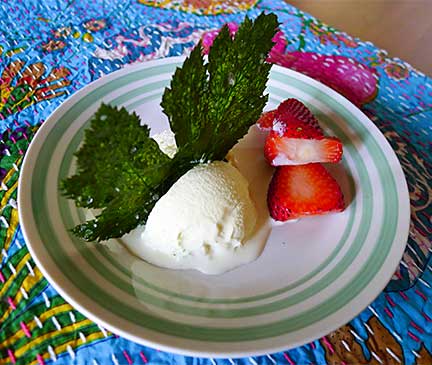
Cow Parsnip Ice Cream with Cow Parsnip Chip and Strawberries. Photograph by Laurie Constantino



